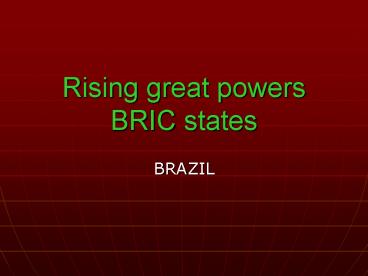Rising great powers BRIC states PowerPoint PPT Presentation
1 / 17
Title: Rising great powers BRIC states
1
Rising great powersBRIC states
- BRAZIL
2
FP adaptation since late 1980s
- End of Cold War
- altered distribution of global power nature of
intl power hierarchy gt US as superpower
reinforcing US hegemony in W hemisphere - Led to decentralization/regionalization
disappearance or weakening of great power
involvement in many areas liberated regional
security dynamics - Economic arena the world of firms, markets,
production, trade - Transnational civil society the world of NGOs
- Globalization
3
Western Hemisphere
4
Impact of globalization on Brazils FP
- Growing interdependence as money, people, images,
values, ideas flow more swiftly across national
boundaries pushing national economy to market
friendly economic policies, i.e. attract foreign
investment technology, to compete in the more
closely linked market place - Military power less relevant
- Intl institutions expand new norms on trade,
human rights, collective security, sustainable
development - Opens door to new political actors or NGOs
demanding changes in domestic global conduct of
states
5
Domestic changes
- Population growth
- 1950 51 million gt 1997 168 million
- Development from rural/agricultural to
industrialized/urbanized society - From coffee ind to mainly manufactured ind
- 1940 36 of pop in cities gt 2000 86 (EU/US)
- 1940 40 nonagricultural employment gt 1980s 70
- Political changes Democratization
- 1964-1985 military govmt
- 1985 civilian govmt, 1989 presidential elections
- New patterns of political mobilization vibrant
civil society
6
Mechanisms of change
- Gradual diffusion of liberal values (democratic
order) as a result of growing interdependence - Hegemonic imposition, i.e. Brazil had little
choice as its FP options narrowed by end of Cold
war reassertion of US regional dominance
absence of alternative options US uses its
power to press its own values policy
preferences through military intervention /
economic sanctions / conditions tied to foreign
assistance or investments
7
Current priorities in FP
- Brazils role in intl institutions
- Brazils regional engagement in SA
- Brazils relation to USA
8
1. Brazils role in intl institutions
- Intl institutions
- Provide political space to build new coalitions
- voice opportunities for smaller states to express
their interests gain political support - useful agents in counterbalance
- Brazil enhanced its role within UN
- 8x in UN Security Council
- Since 1991 increased involvement in UN
peacekeeping election monitoring activities
(Africa, Balkans, Latin America, Asia)
9
2. Brazils regional engagement in SA
- Since 1990 progress in regional security arms
control - lt Brazil renounced desire to acquire nuclear
weapons - lt 1991 agreement between Brazil, Argentina, IAEA
rendering South America as a nuclear-free zone
later extended to Chile arms control over
chemical and biological weapons - Creation of Mercosur by Brazil, Argentina,
Paraguay, Uruguay in 1991 - promote free trade and the fluid movement of
goods, people, and currency - Important force for regional economic cooperation
rival of NAFTA (1994) EU (!)
10
(No Transcript)
11
(No Transcript)
12
(No Transcript)
13
Mercosur
- 3rd largest economic bloc in the world after EU,
NAFTA - Intraregional trade
- 1991 5 billion gt 1997 20 billion
- Much of investments that previously had to go to
Asia emerged in Mercosur - Counterweight to US
- ltgt Brazil adopted unilateral protectionist
measures to the disadvantage of Argentine
14
3. Brazils relation to USA
- Atmosphere
- Absence of bilateral engagement mature
dialogue - Belief that Brazil is different powerful enough
to stand apart, to preserve a considerable degree
of freedom - ltgt US exports more to Brazil than to China, RUS,
India (of top 500 US corporations, 420 operate in
Brazil) gtUS economically central to Brazil - as a source of foreign investment
- As a market, esp for manufactured goods
(aircraft, automobile parts, shoes) limits
bargaining power
15
Washington vs. Brasilia
- US interests harmed by Brazilian economic reforms
- US restrictions on import of Brazilian products
(steel, sugar, shoes, textiles, orange juice,
meat) - Within WTO several cases ongoing
- lt different images through past history mutual
images (US as hegemonic, natural leader in its
backyard, Brs resentment not to be taken
seriously in Washington)
16
Conclusion
- Brazil is Latin Americas
- Largest, most populous and economically most
productive country - Since late 1980s turning point in domestic and FP
- lt end of cold war accelerating pace of
economic and social globalization - gt modified Brazils understanding of its place
in the world - Expanded its ties with WE, JAP,
- Instead on focusing on economy, Brazil became
more accepting of dominant international norms in
other issues, such as arms industry, environment,
human rights - US hegemony acts as major constraint on BR FP
- ability to set regional agenda through material
ideational power resources
17
- Steven W. Hook (ed) Comparative Foreign Policy.
Adaptation Strategies of the Great and Emerging
Powers. New Jersey Pearson, 2002.

